
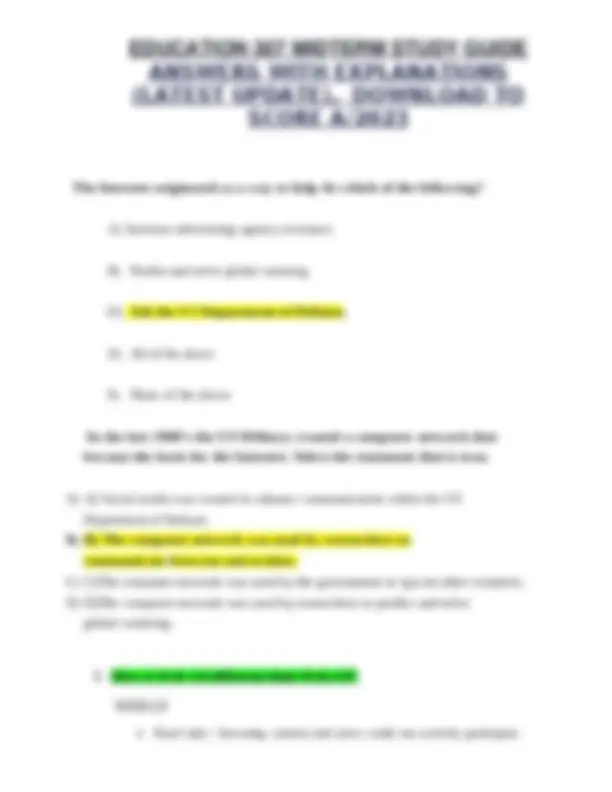
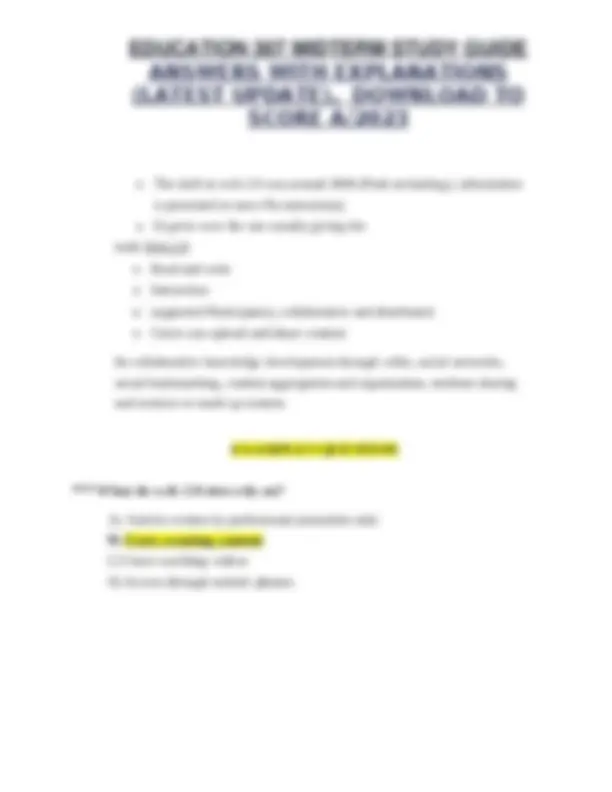
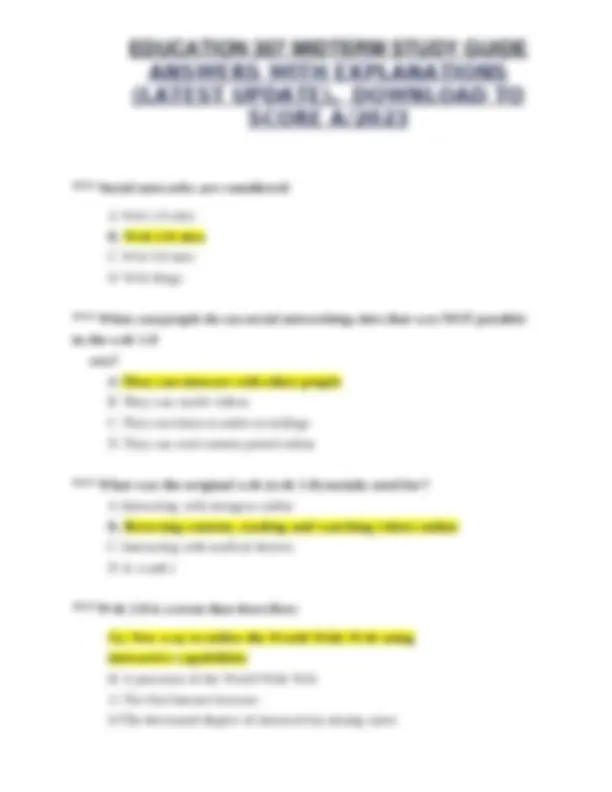
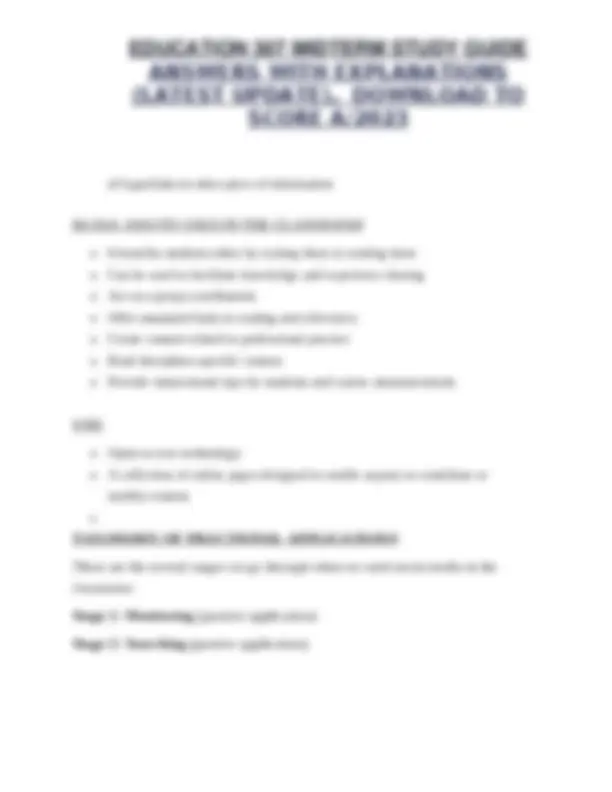
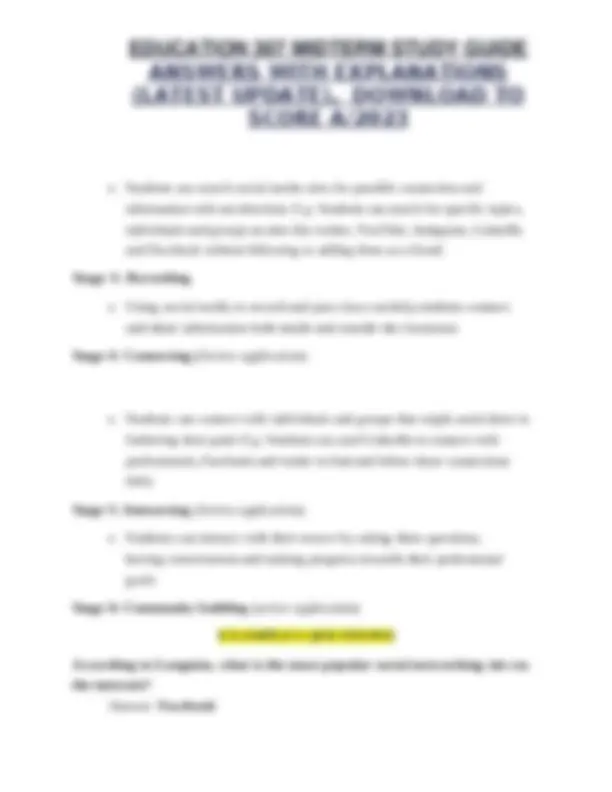
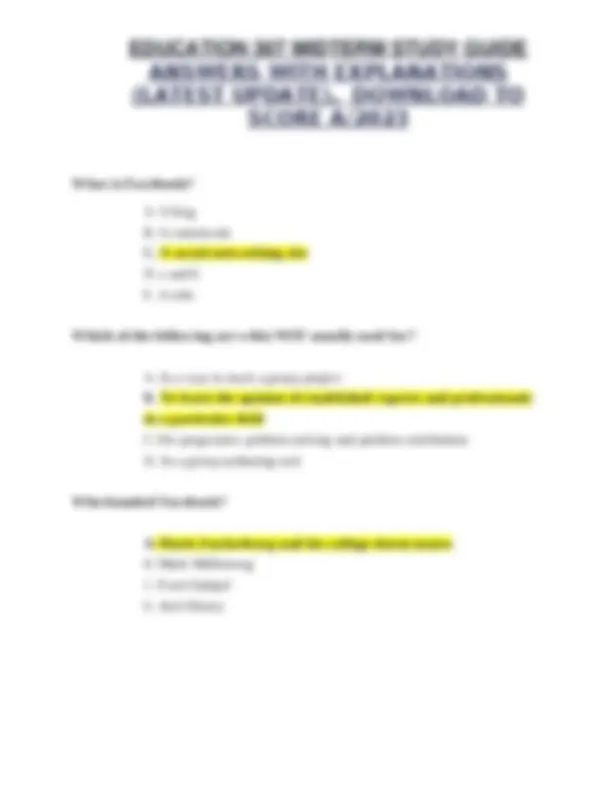
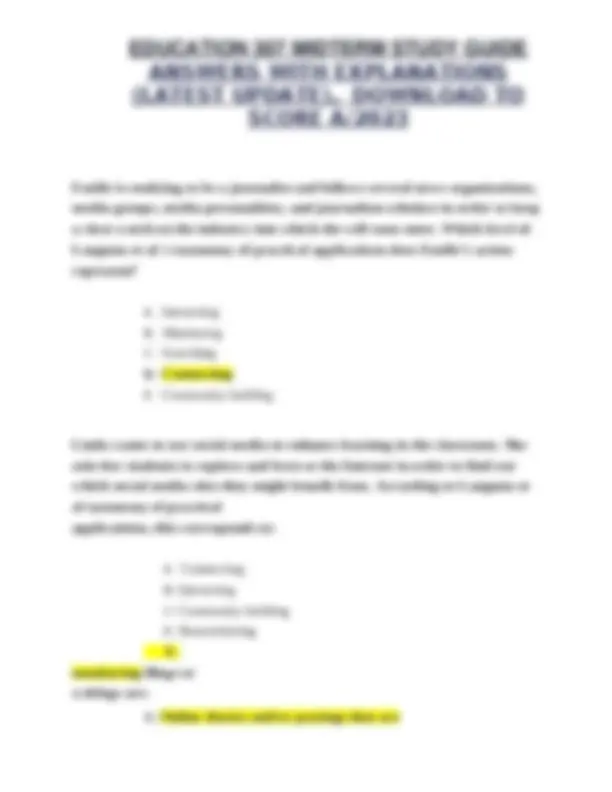
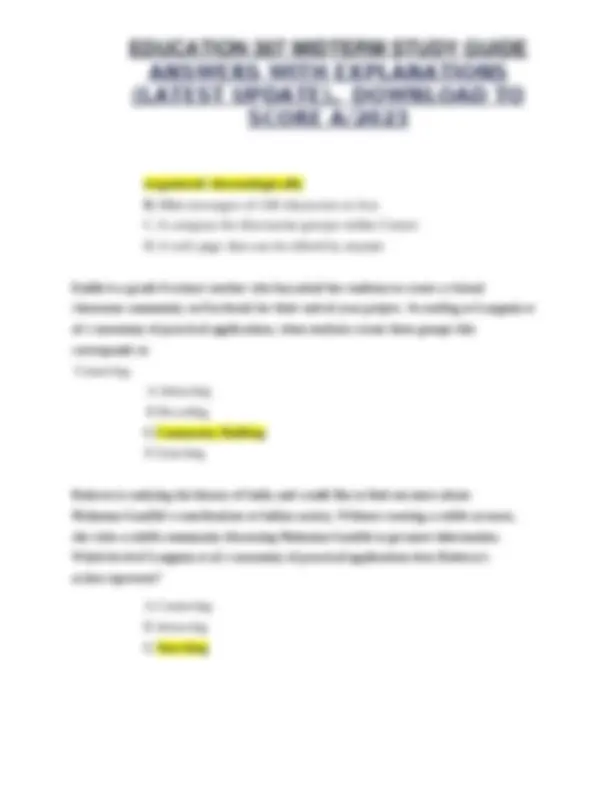
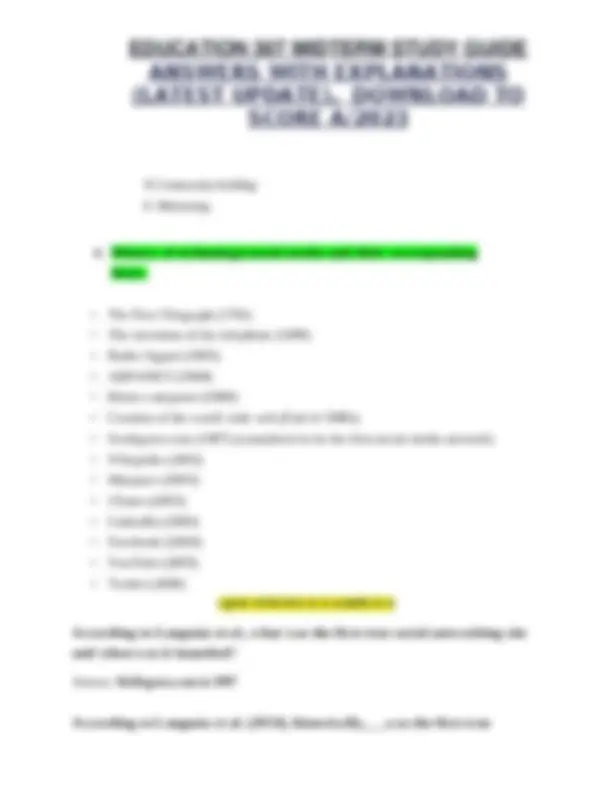
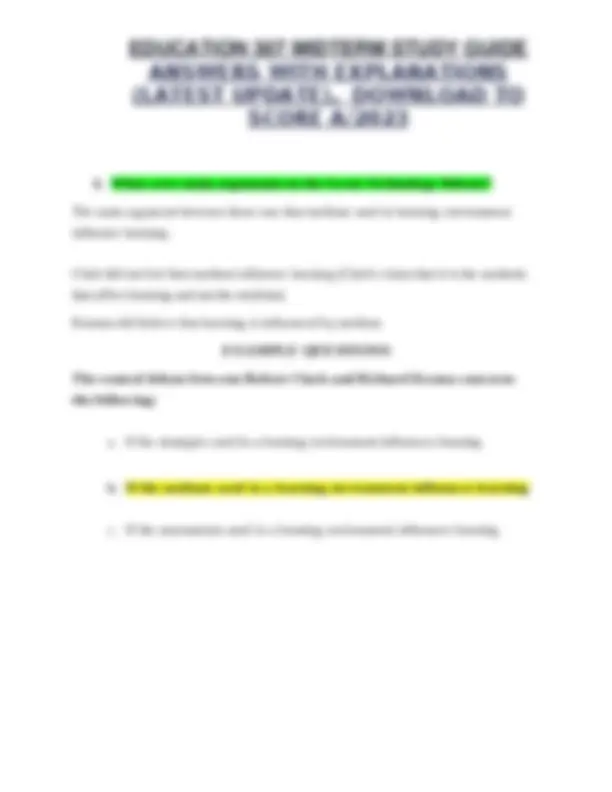
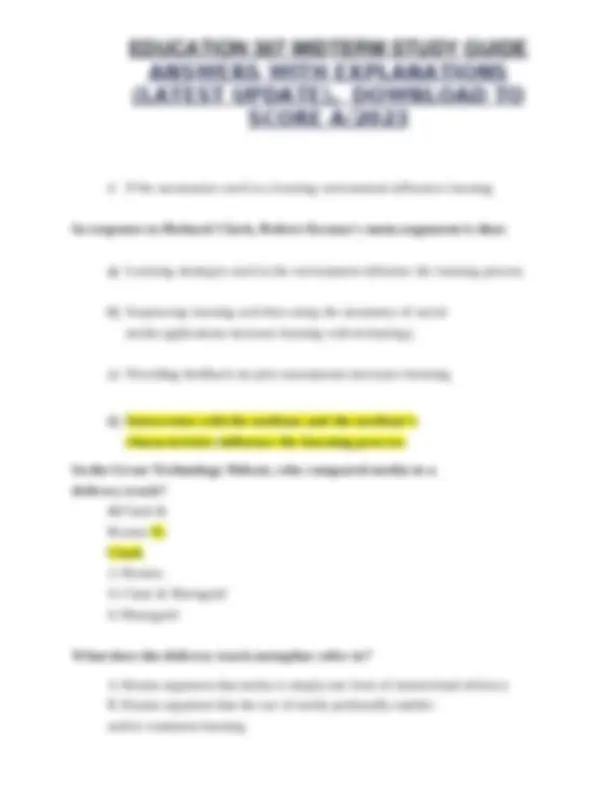
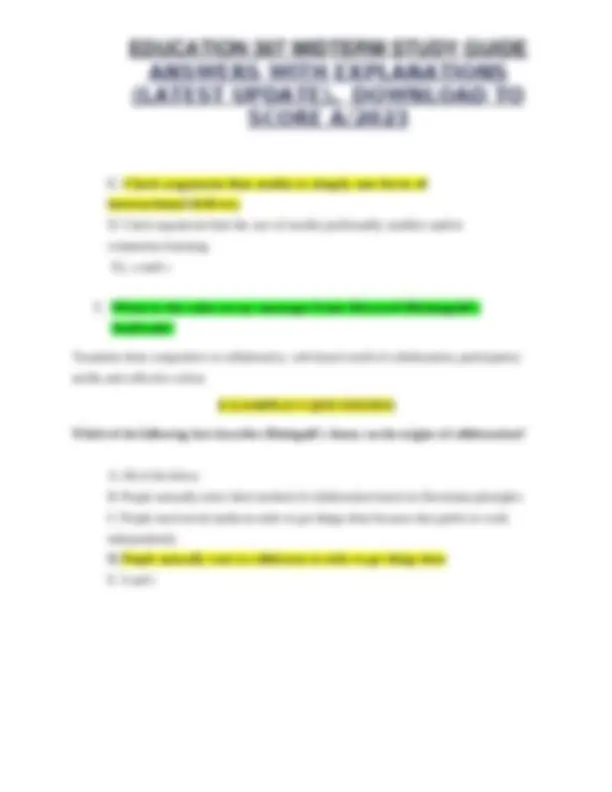
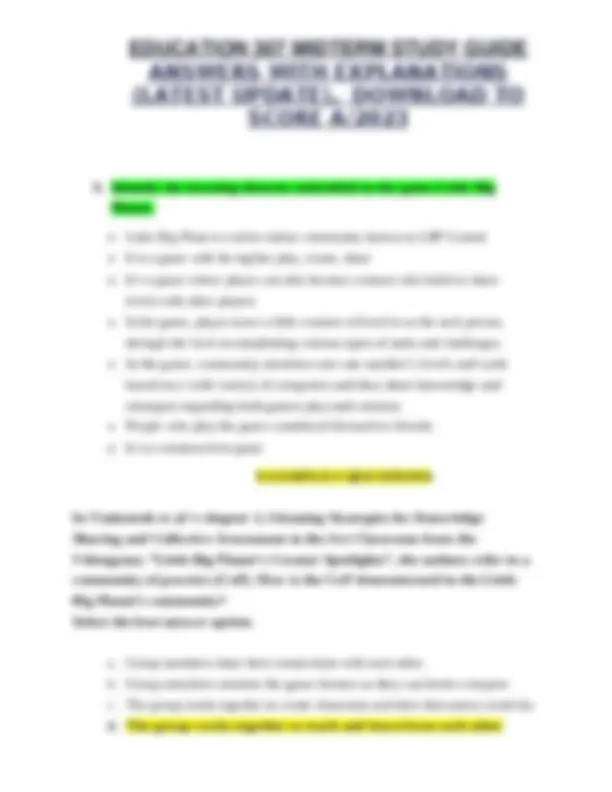
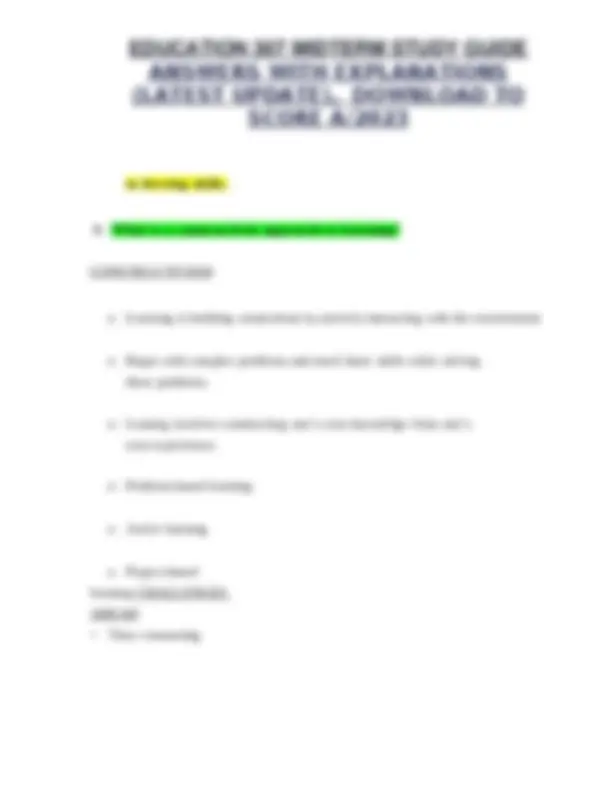
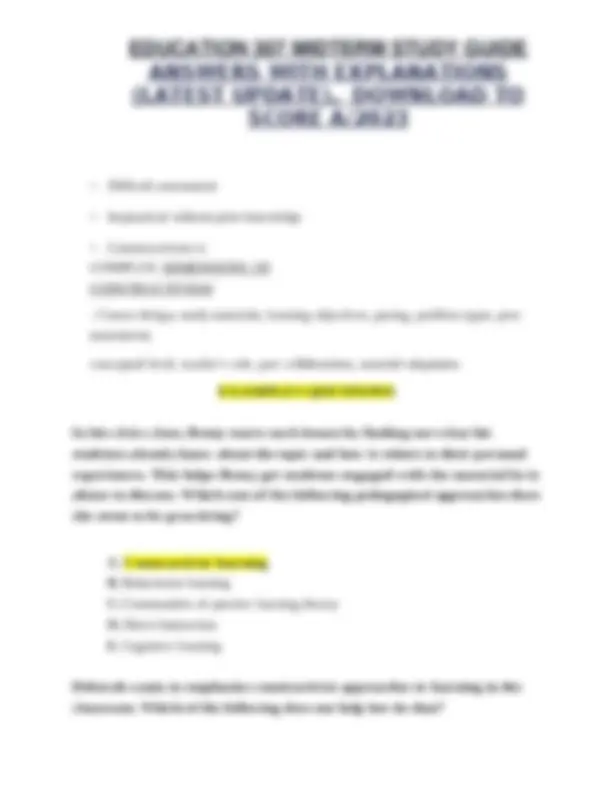
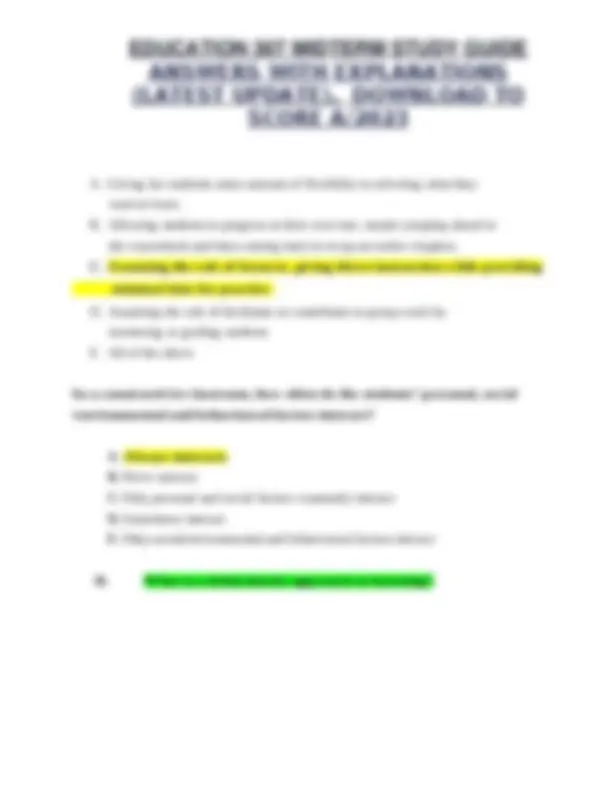
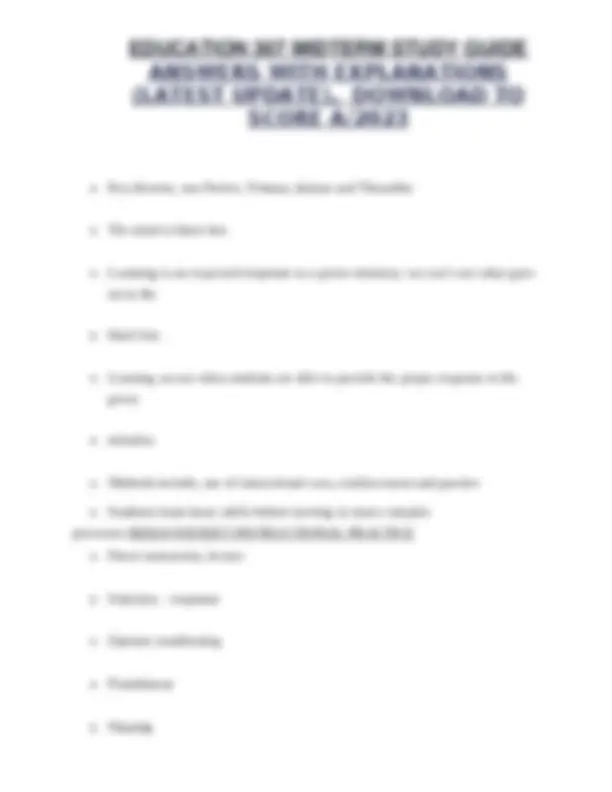
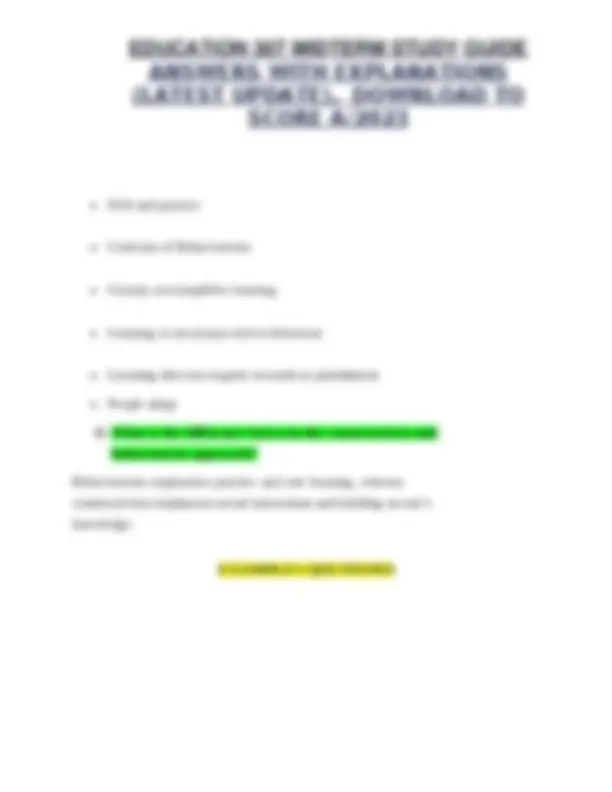
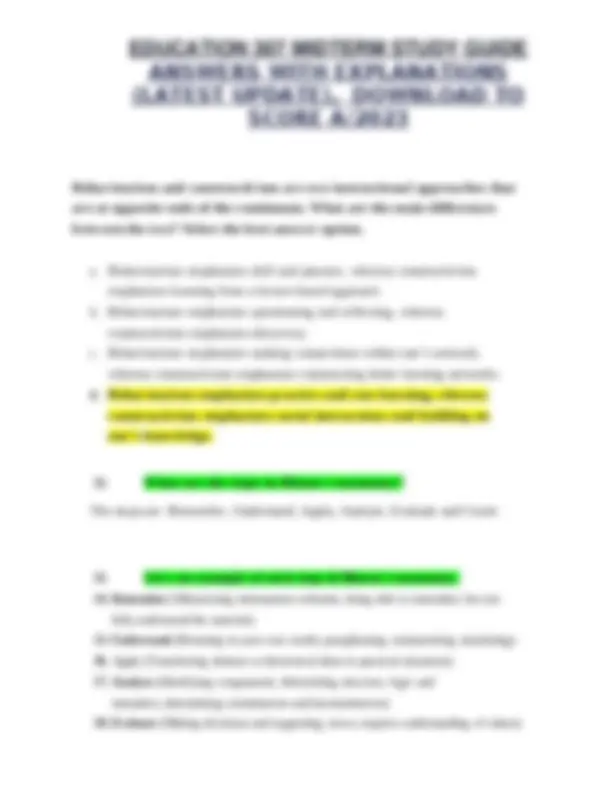
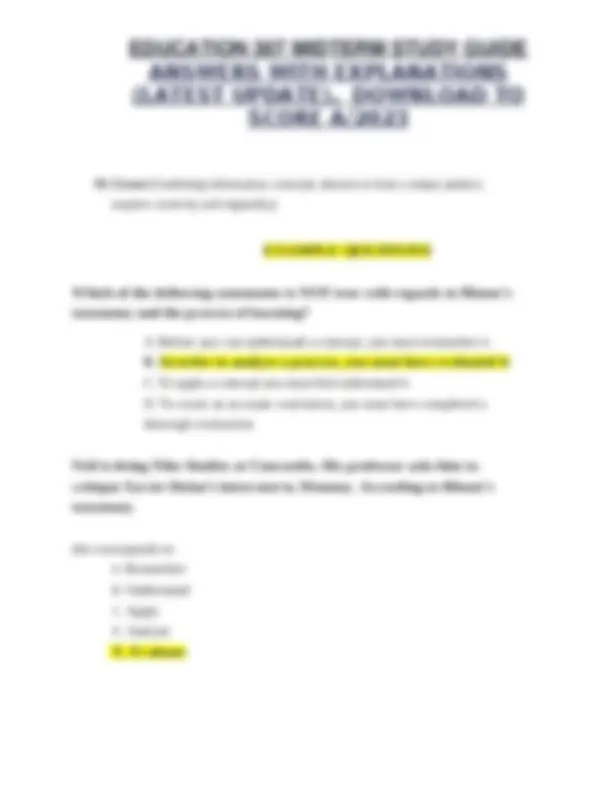
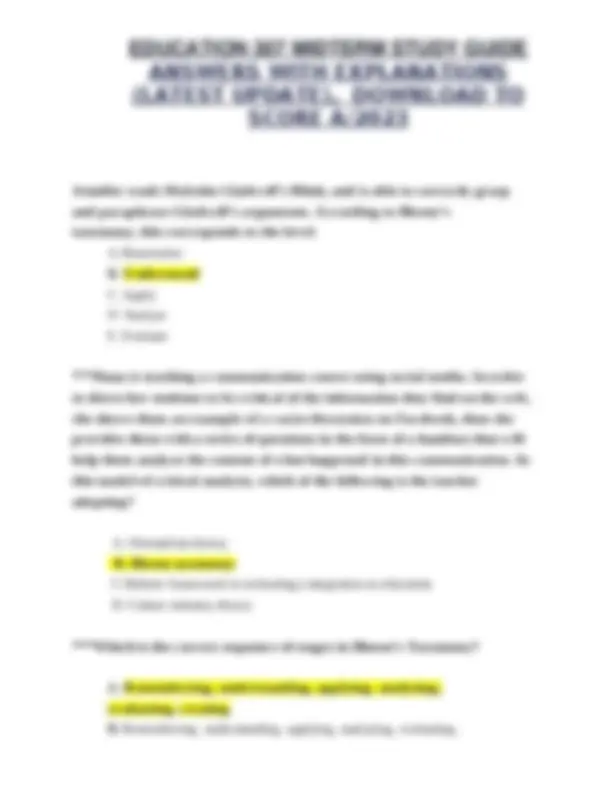
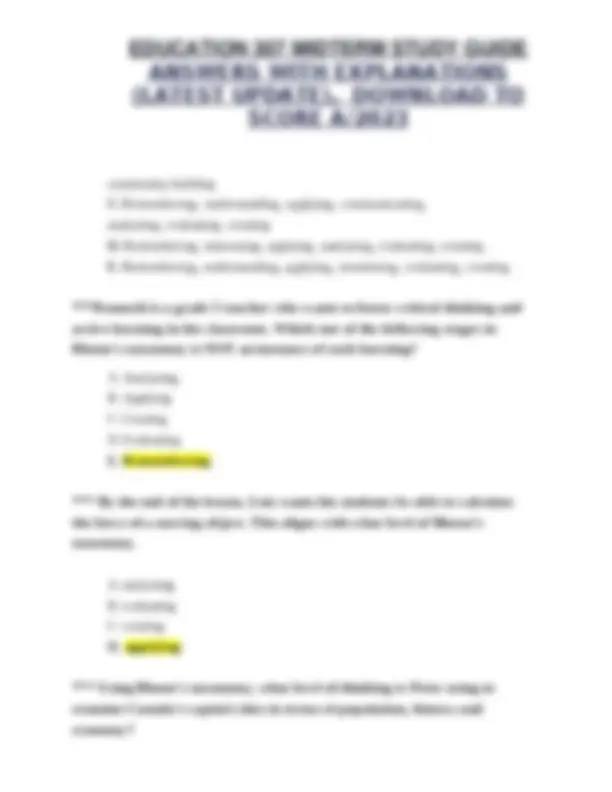
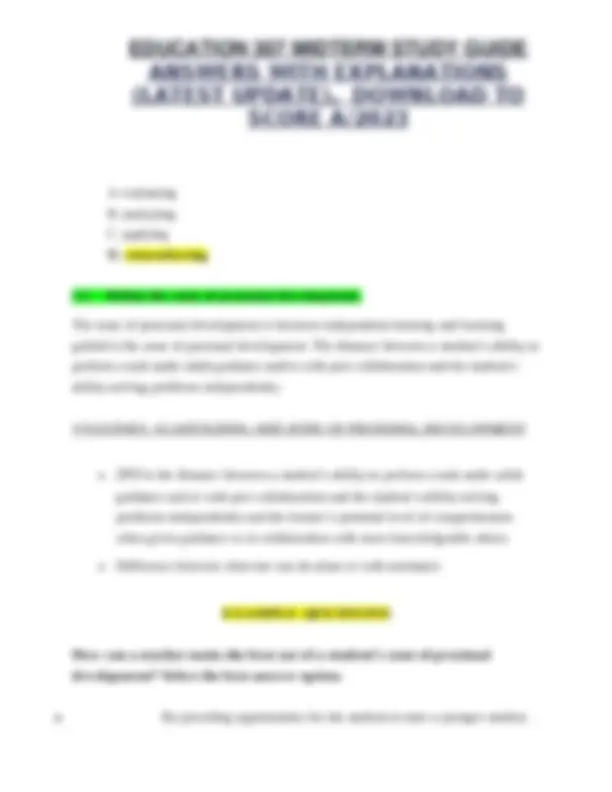
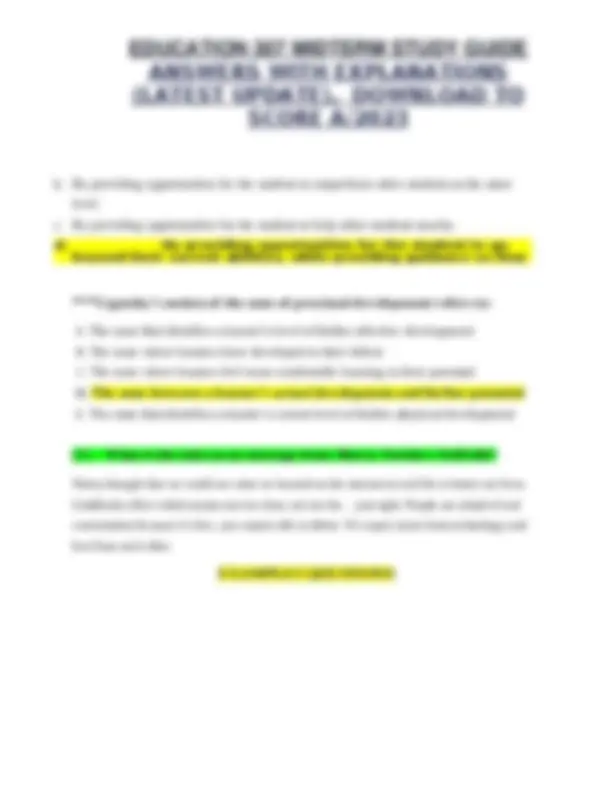
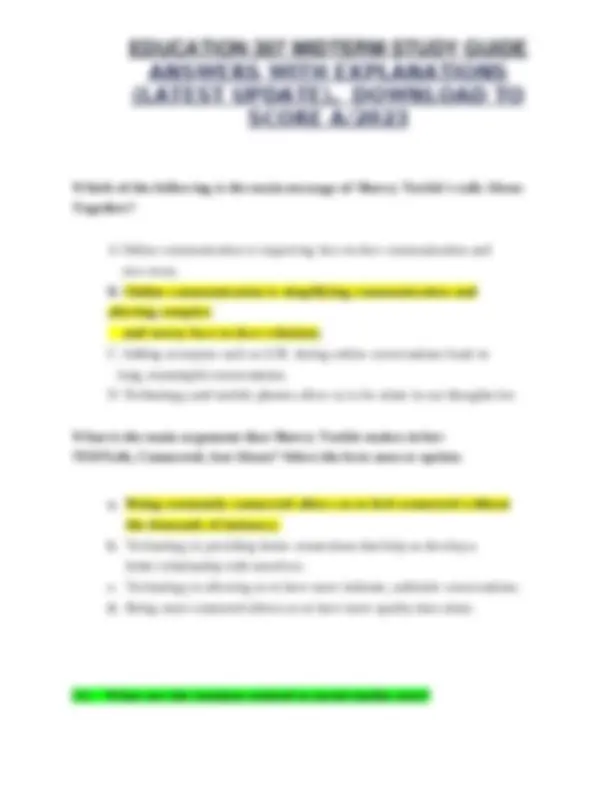
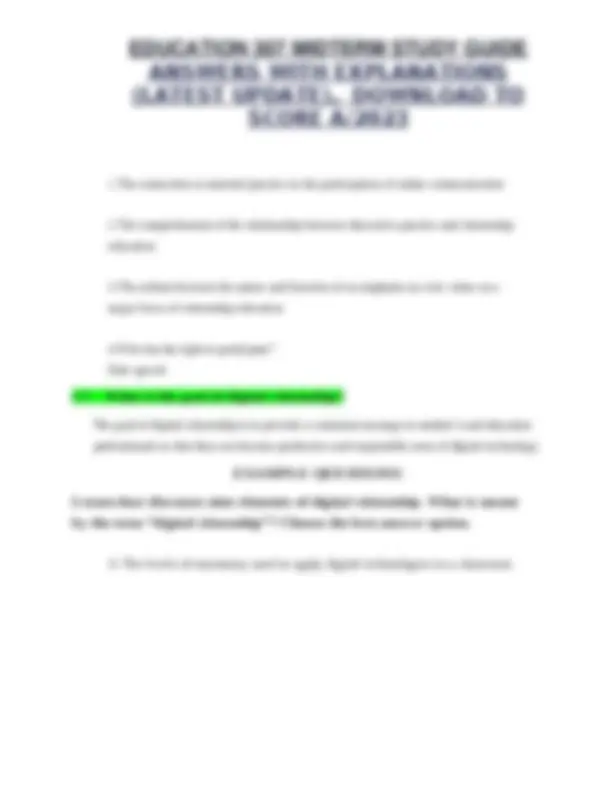
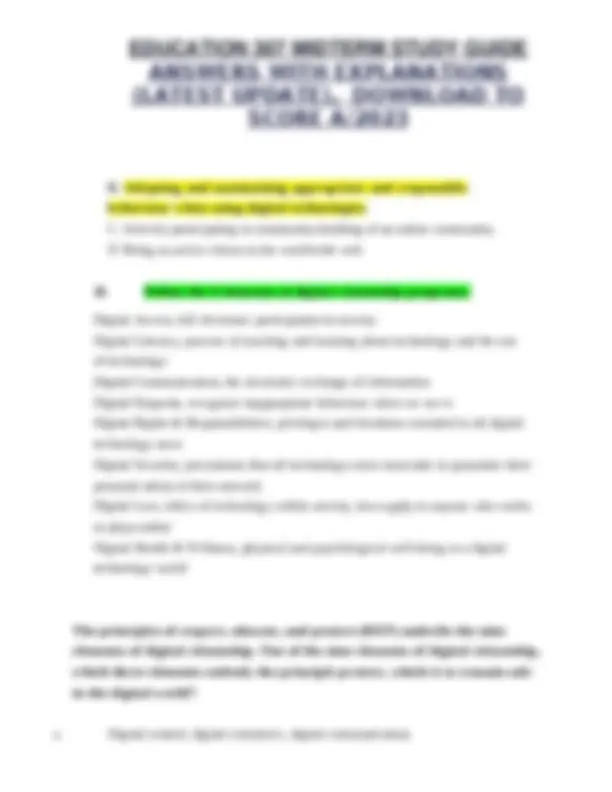
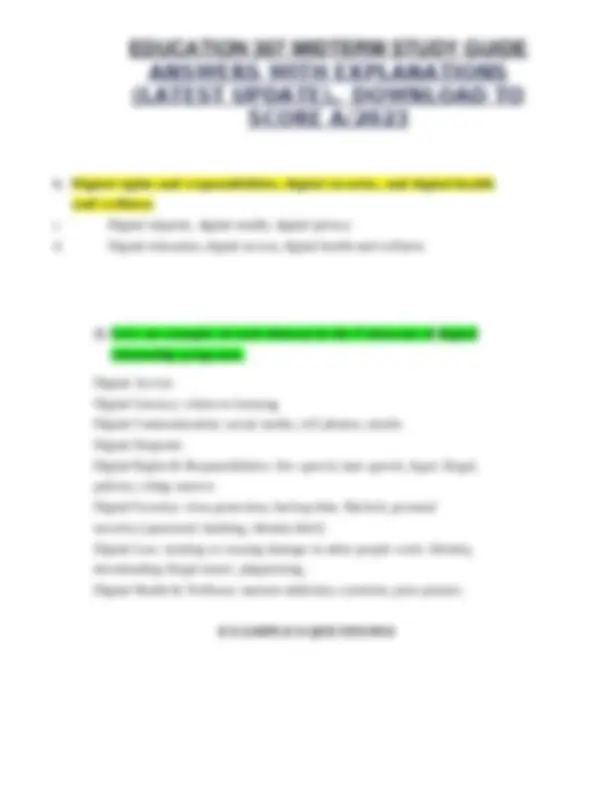
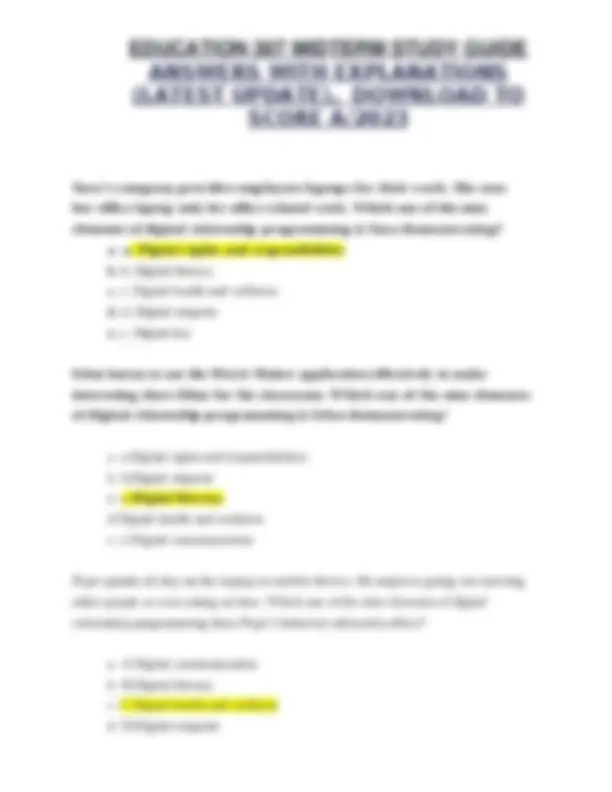
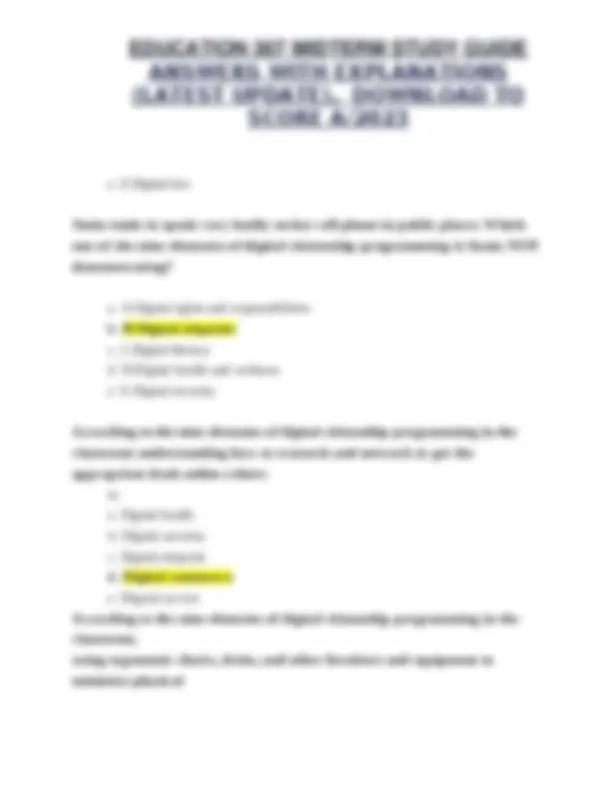
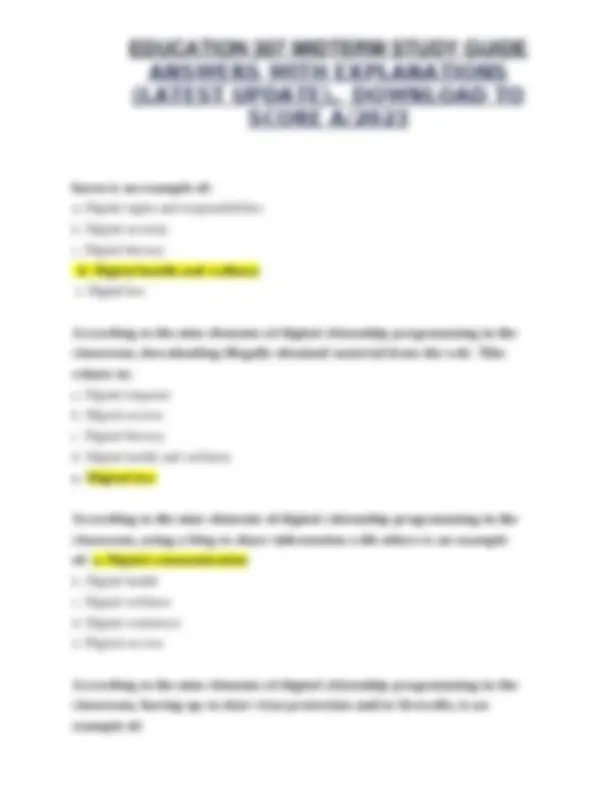
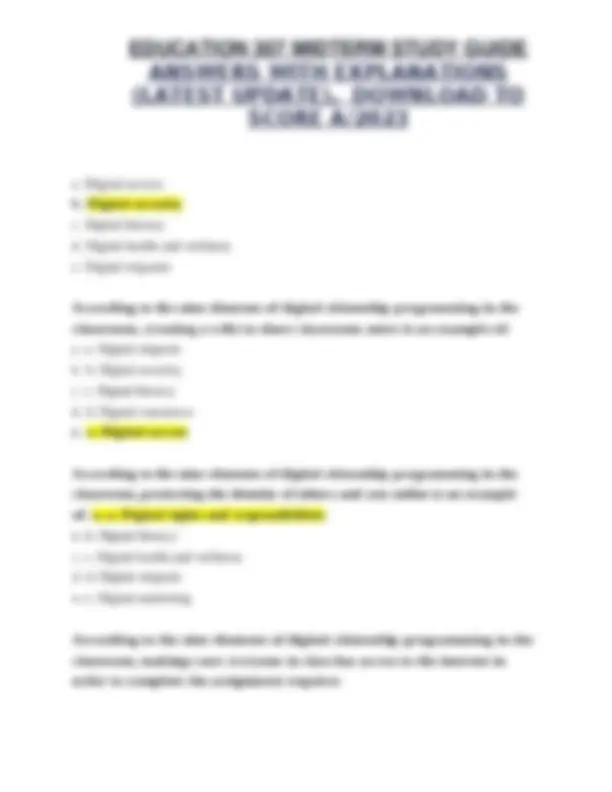
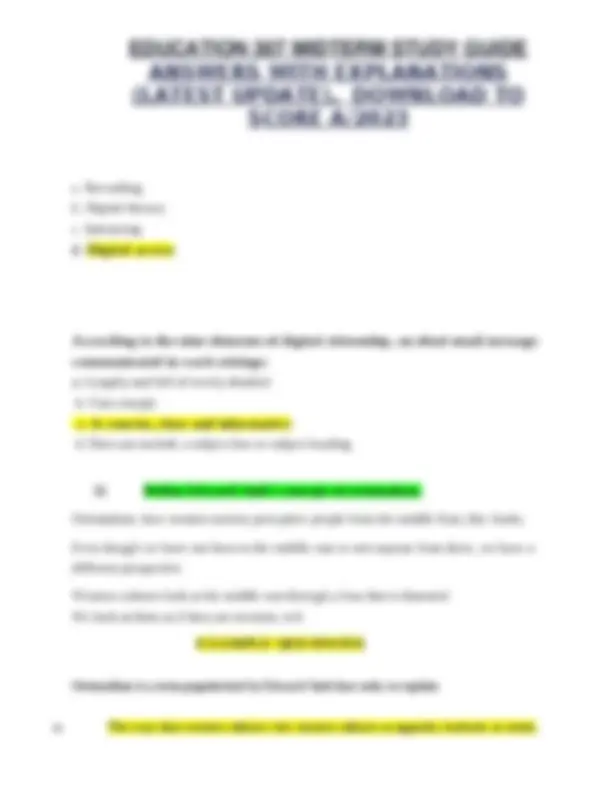
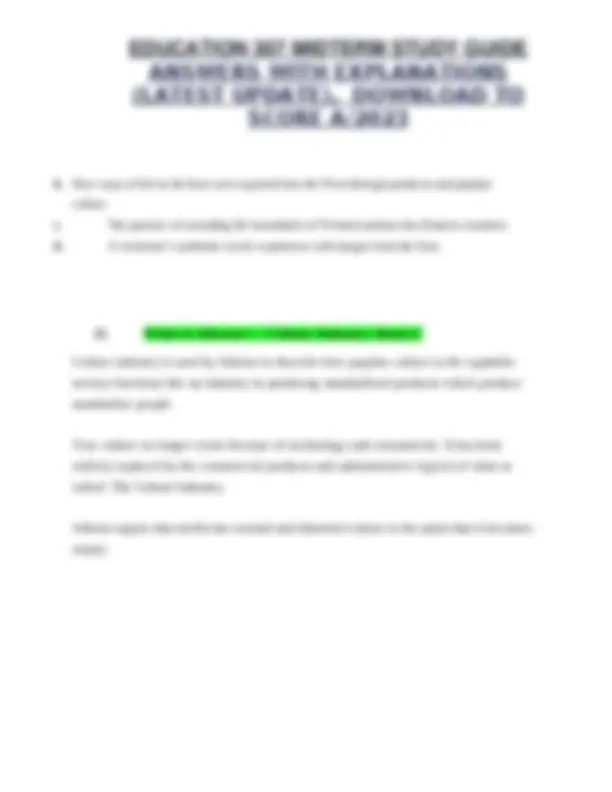
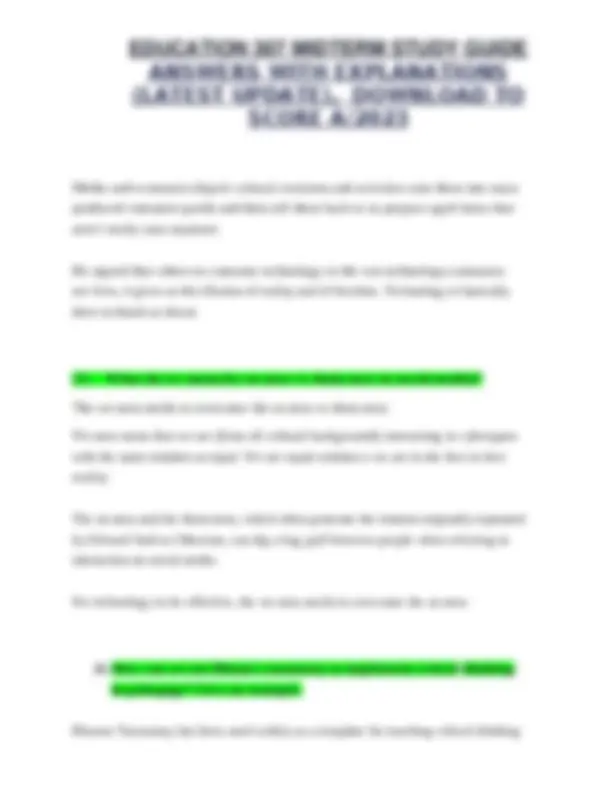
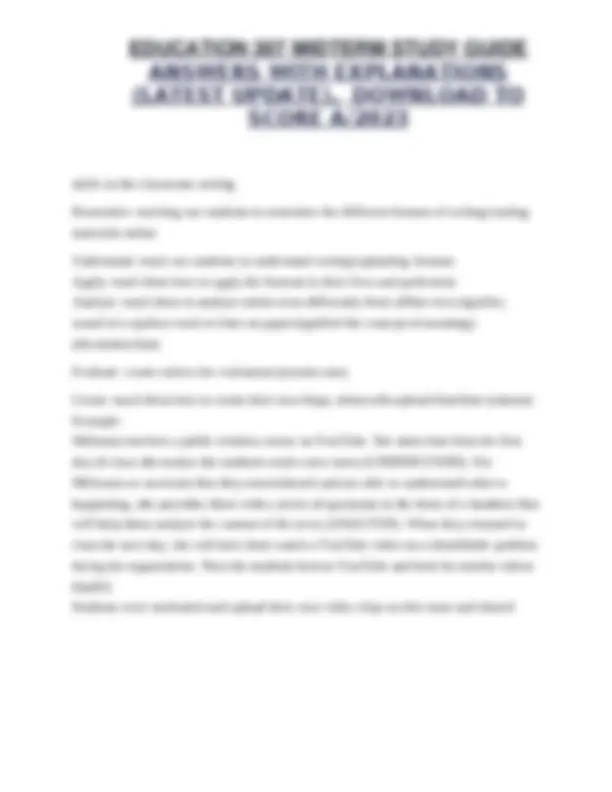
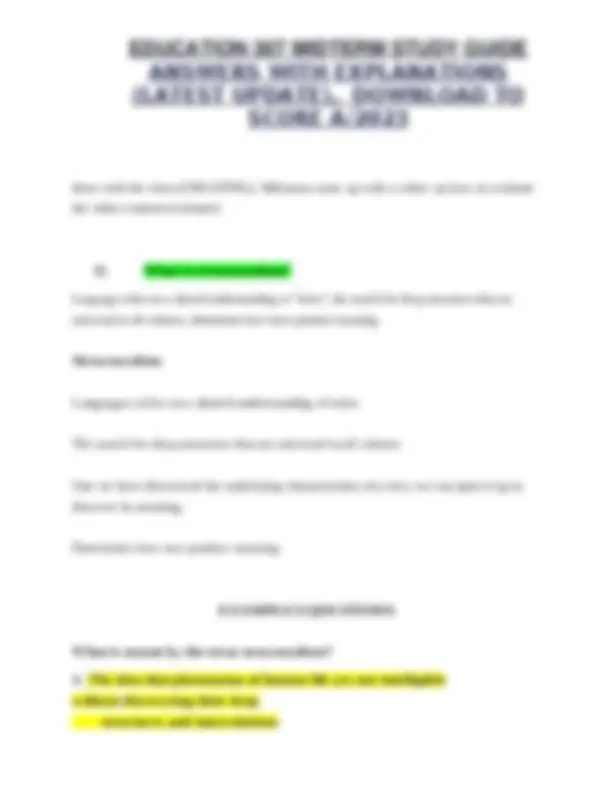
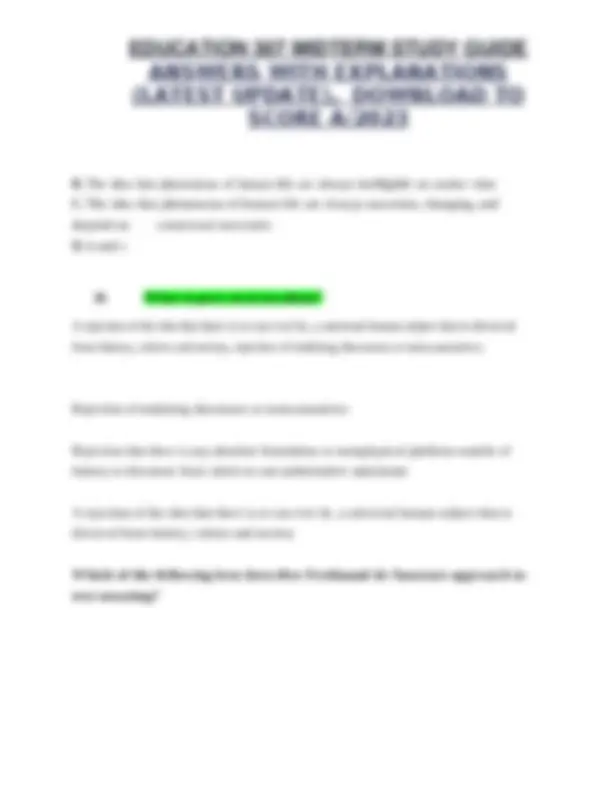
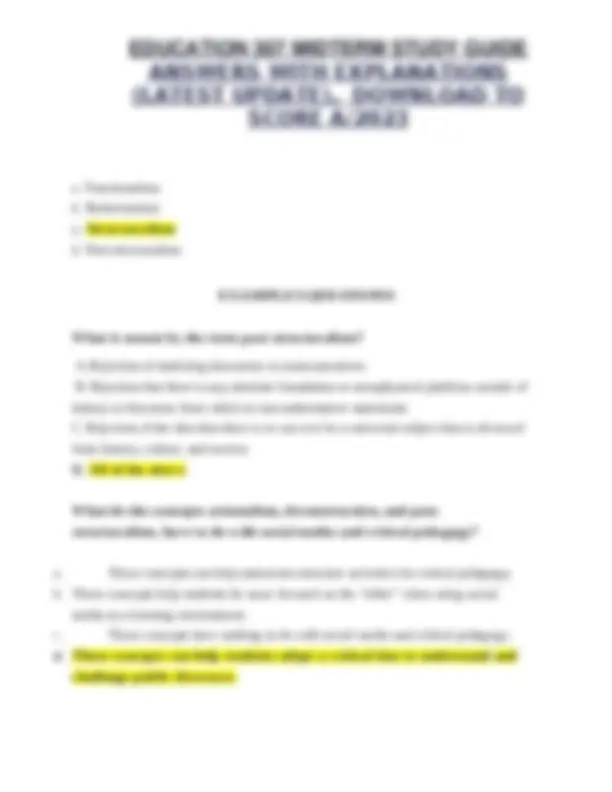
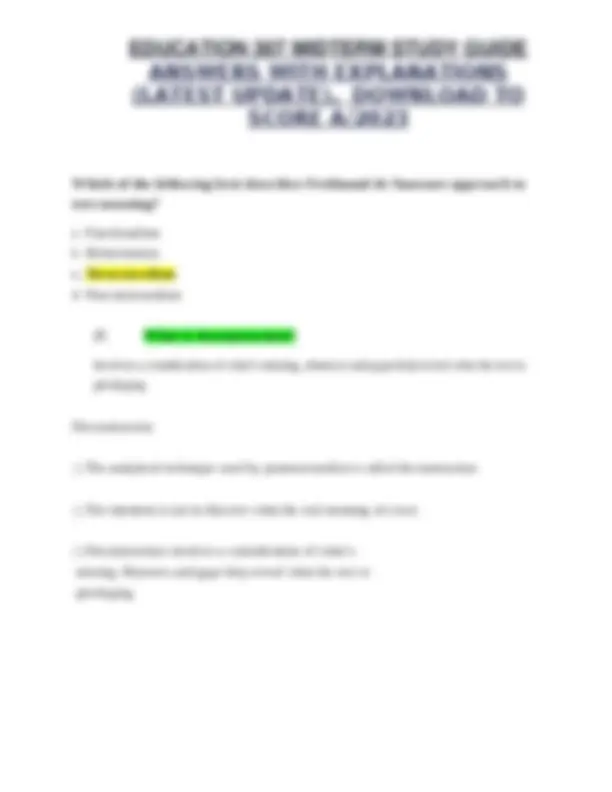
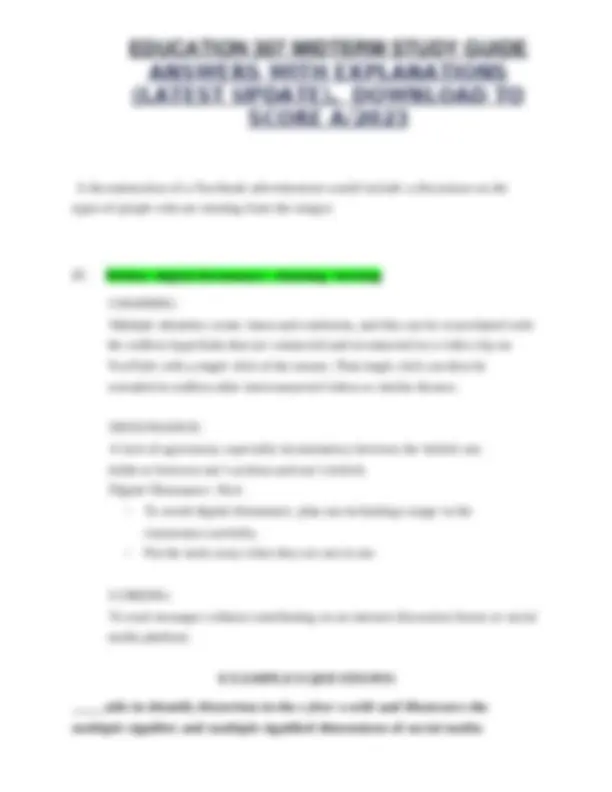
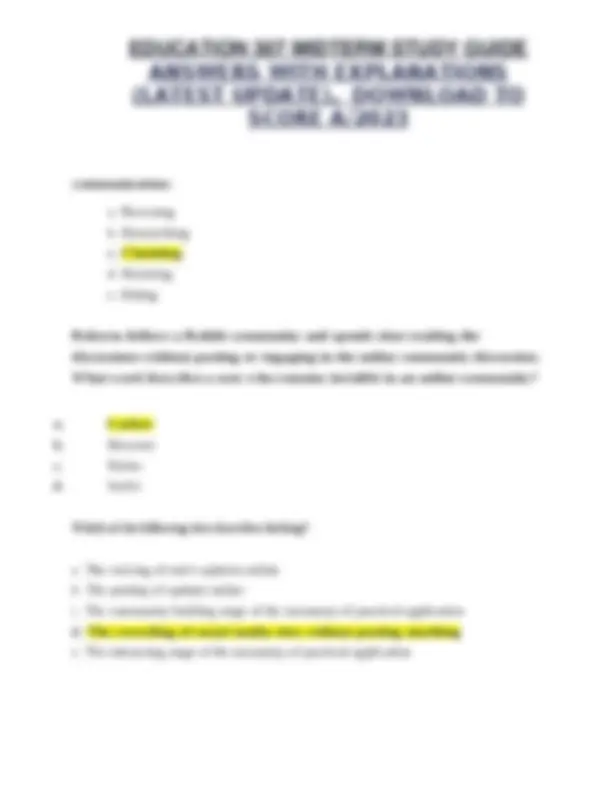
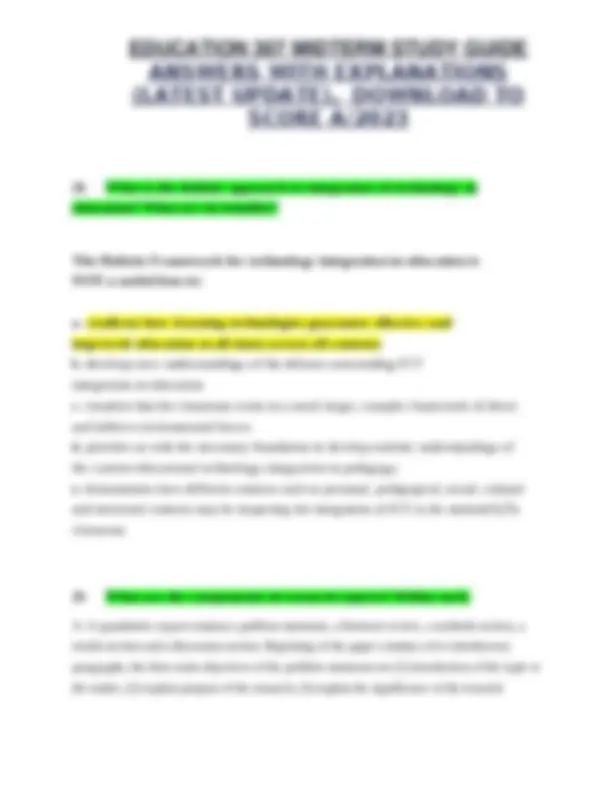
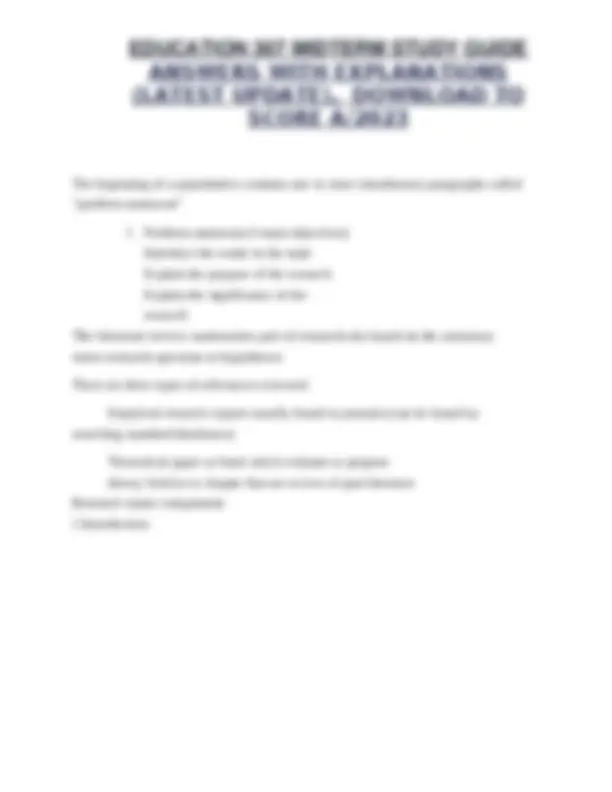
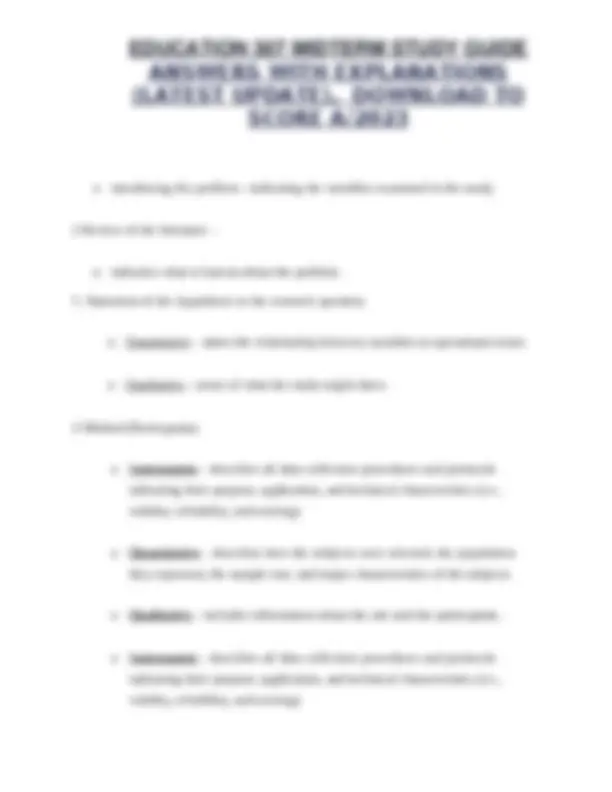
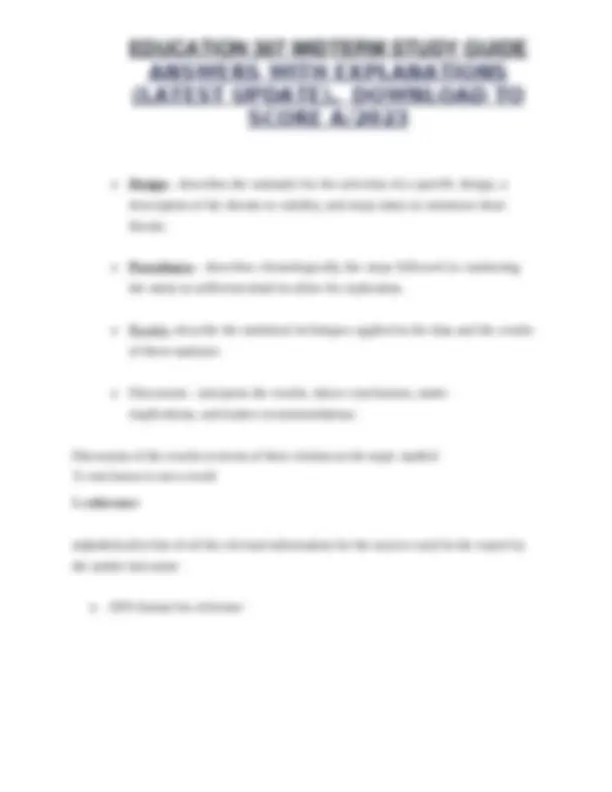
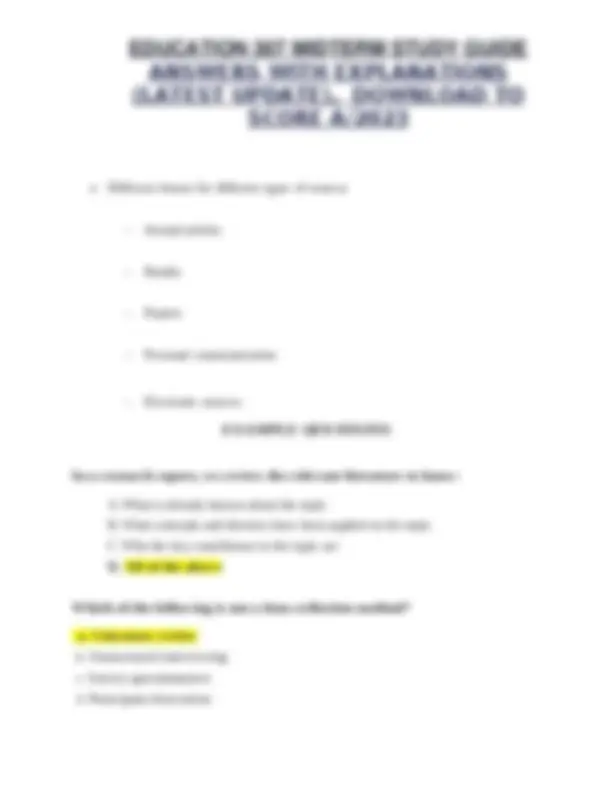
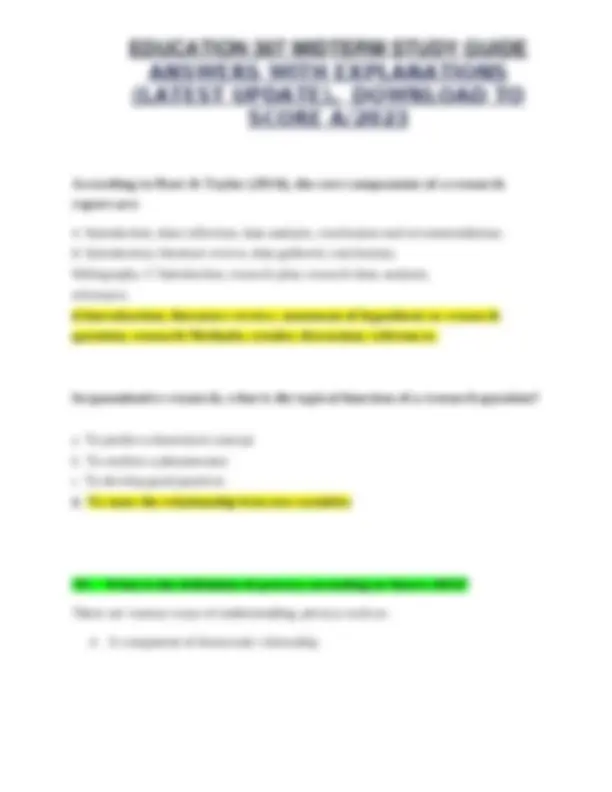
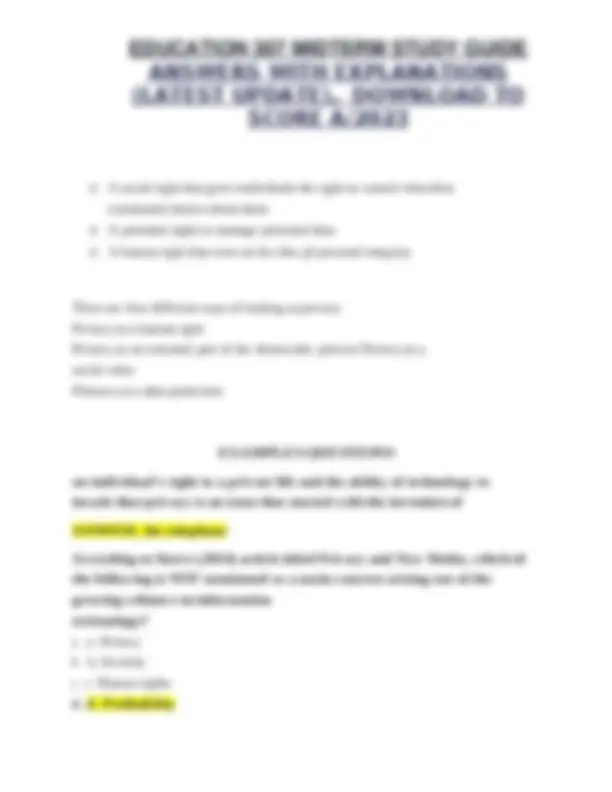
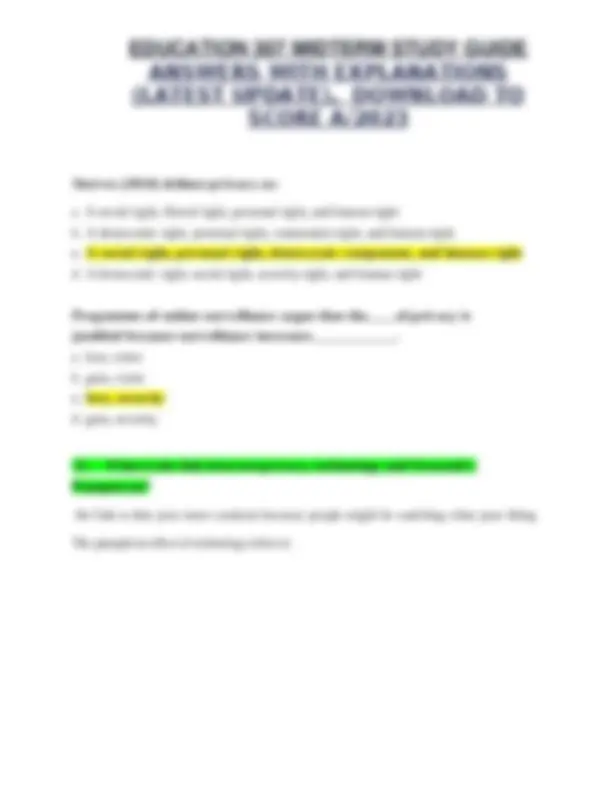
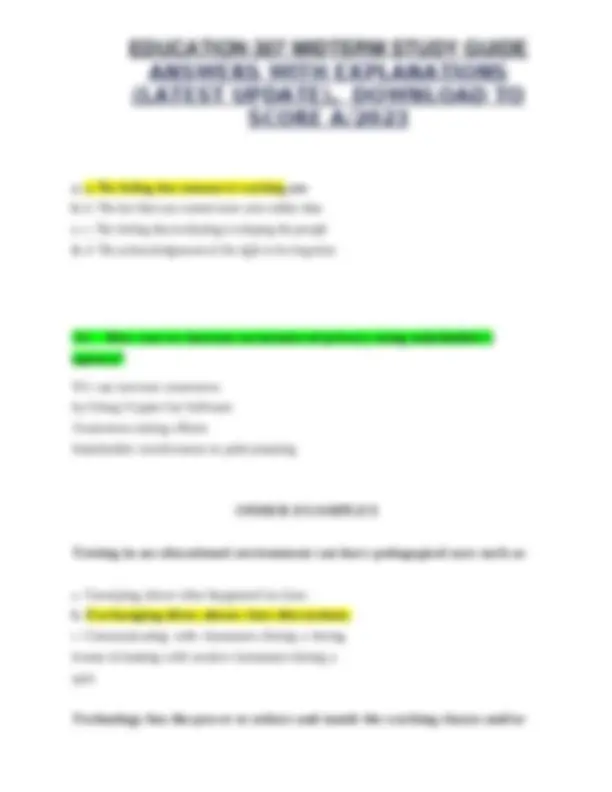
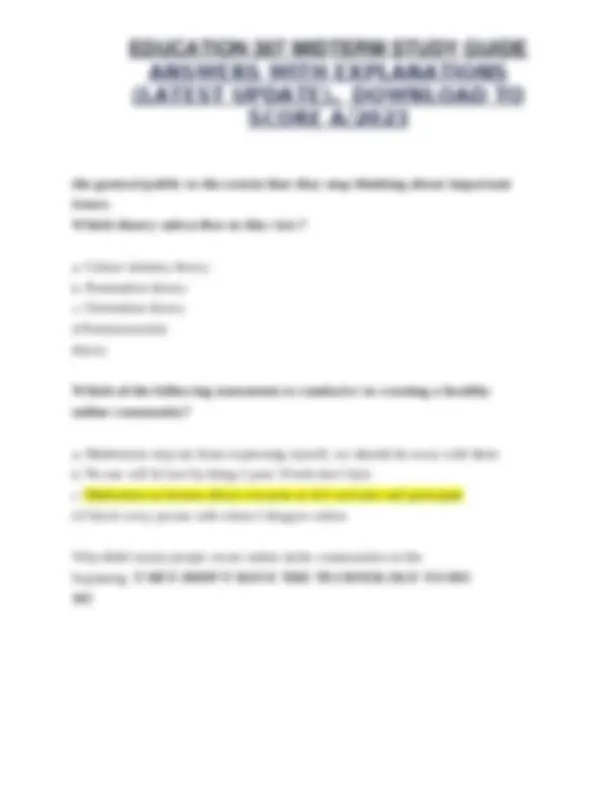


Study with the several resources on Docsity

Earn points by helping other students or get them with a premium plan


Prepare for your exams
Study with the several resources on Docsity

Earn points to download
Earn points by helping other students or get them with a premium plan
Community
Ask the community for help and clear up your study doubts
Discover the best universities in your country according to Docsity users
Free resources
Download our free guides on studying techniques, anxiety management strategies, and thesis advice from Docsity tutors
EDUCATION 307 MIDTERM STUDY GUIDE ANSWERS WITH EXPLANATIONS (LATEST UPDATE), DOWNLOAD TO SCORE A/2023
Typology: Study Guides, Projects, Research
1 / 60

This page cannot be seen from the preview
Don't miss anything!





















































reviews, comments and feedback. C). Digital forms of communication through which individuals create online communities to share information, ideas, personal messages, and related content. D) A platform only for professionals in specific fields to share information, ideas, personal messages, and other content (videos) ***** Educators believe learning with social media is important because:** A) It allows students to meet experts online B) It allows students to form online niche communities C) Students can learn with each other and from each other D) Social media tools can boost student engagement E) All of the above The ARPAnet, or Advanced Research Projects Agency Network, was a computer network created by in the late 1960s. A) The U.S. military B) Bell Telephone C) The Soviet government D) The National Science Foundation E) The USSR military
o The shift to web 2.0 was around 2004 (Push technology, information is presented to users No interaction) o Experts were the one usually giving the truth Web 2. o Read and write o Interaction o supported Participatory, collaborative and distributed. o Users can upload and share content Its collaborative knowledge development through wikis, social networks, social bookmarking, content aggregation and organization, medium sharing and remixes or mash up content. EXAMPLES QUESTION *** What do web 2.0 sites rely on? A) Articles written by professional journalists only B) Users creating content C) Users watching videos D) Access through mobile phones
***** Social networks are considered** A. Web 1.0 sites B. Web 2.0 sites C. Web 3.0 sites D. Web blogs ***** What can people do on social networking sites that was NOT possible in the web 1. era? A. They can interact with other people** B. They can watch videos C. They can listen to audio recordings D. They can read content posted online ***** What was the original web (web 1.0) mainly used for?** A. Interacting with strangers online B. Browsing content, reading and watching videos online C. Interacting with medical doctors D. d. a and c ***** Web 2.0 is a term that describes: A). New way to utilize the World Wide Web using interactive capabilities** B) A precursor of the World Wide Web C) The first Internet browser D)The decreased degree of interactivity among users
o Build a Facebook group and add PowerPoint slides, visuals, videos, transcripts o Connect with each other outside of the classroom. o Using Facebook apps, you can help students create flash cards to study the classroom material. TWITTER o Is known as micro blogging o Twitter, which launched in 2006, allows users to follow other users and allows for cross platform connectivity o Gives users opportunity with people from both casual and business purposes o Encourages participants to reach beyond their physical connections and form virtual relationships with other professionals in field. BLOGS o Known as web logs o Was created in the early 1990s o Is known as online diaries o They allow anyone to publish information online o Some teacher blogs to useful teaching tools because it provided space for students to reflect on learning and publish their thoughts o They allow professors and students to exchange ideas and feedback o They encourage knowledge that is relational and contextual through the use
of hyperlinks to other piece of information BLOGS AND ITS USED IN THE CLASSROOM o It benefits students either by writing them or reading them o Can be used to facilitate knowledge and experience sharing o Act as a group coordination o Offer annotated links to reading and references o Create content related to professional practice o Read disciplines specific content o Provide instructional tips for students and course announcements WIKI o Open access technology o A collection of online pages designed to enable anyone to contribute or modify content. o TAXONOMY OF PRACTIONAL APPLICATIONS These are the several stages we go through when we used social media in the classrooms Stage 1: Monitoring (passive application) Stage 2: Searching (passive application)
What is Facebook? A. A blog B. A content site C. A social networking site D. a and b E. A wiki Which of the following are wikis NOT usually used for? A. As a way to track a group project B. To learn the opinion of established experts and professionals in a particular field C. For progressive problem-solving and problem redefinition D. As a group authoring tool Who founded Facebook? A Mark Zuckerberg and his college dorm mates B. Mark Mullenweg C. Evan Spiegel D. Jack Dorsey
In chapter 2 of Langmia et al., Jennifer Cox discusses two main challenges to using Twitter in the classroom. Select the two correct answers. A. It can be a distraction. B. It can be overwhelming due to information overload. C. It can allow students to interact with other experts. D. It can allow students to ‘friend’ each other. According to Langmia et al., the taxonomy of practical applications for incorporating social media into curricula is composed of 6 steps: A. Knowing, searching, recording, applying, interacting, community building B. Monitoring, searching, recording, connecting, evaluating, community building C. Monitoring, searching, applying, connecting, interacting, community building D. Monitoring, searching, recording, connecting, interacting, community building Ratna would like to use a social media platform for her CEGEP students so that they can benefit from access to PowerPoint slides, visuals, videos, and transcripts from her lectures even after the course is over. She scans publicly available social media sites for possible ways to do this. To which of the following does this correspond, according to Langmia et al. taxonomy of practical applications?
Emilie is studying to be a journalist and follows several news organizations, media groups, media personalities, and journalism scholars in order to keep a close watch on the industry into which she will soon enter. Which level of Langmia et al.'s taxonomy of practical applications does Emilie’s action represent? A. Interacting B. Monitoring C. Searching D. Connecting E. Community building Linda wants to use social media to enhance learning in the classroom. She asks her students to explore and browse the Internet in order to find out which social media sites they might benefit from. According to Langmia et al taxonomy of practical applications, this corresponds to: A. Connecting B. Interacting C. Community building D. Remembering E. monitoring Blogs or weblogs are: A. Online diaries and/or postings that are
organized chronologically B. Mini messages of 140 characters or less C.A category for discussion groups within Usenet D.A web page that can be edited by anyone Emilie is a grade 6 science teacher who has asked her students to create a virtual classroom community on Facebook for their end-of-year project. According to Langmia et al.'s taxonomy of practical applications, when students create these groups this corresponds to Connecting A.Interacting B. Recording C.Community Building D. Searching Roberta is studying the history of India and would like to find out more about Mahatma Gandhi’s contributions to Indian society. Without creating a reddit account, she visits a reddit community discussing Mahatma Gandhi to get more information. Which level of Langmia et al.'s taxonomy of practical applications does Roberta's action represent? A.Connecting B. Interacting C.Searching
social media site. A) YouTube B) LinkedIn C) Wikipedia D) Facebook E) SixDegrees.com According to Langmia et al. (2014), social media development is linked to the following historical milestone(s): A) The invention of the telegraph B) The invention of the telephone C) The invention of radio signals D) All of the above
5. What should teachers take into consideration when incorporating new technologies including social media in the classroom? Teachers should take into consideration:
d. If the taxonomies used in a learning environment influences learning In response to Richard Clark, Robert Kozma’s main argument is that: a) Learning strategies used in the environment influence the learning process. b) Sequencing learning activities using the taxonomy of social media applications increases learning with technology. c) Providing feedback on peer assessments increases learning. d) Interaction with the medium and the medium’s characteristics influence the learning process. In the Great Technology Debate, who compared media to a delivery truck? A) Clark & Kozma B) Clark C) Kozma D) Clark & Rheingold E) Rheingold What does the delivery truck metaphor refer to? A. Kozma argument that media is simply one form of instructional delivery B. Kozma argument that the use of media profoundly enables and/or constrains learning
C. Clark argument that media is simply one form of instructional delivery D. Clark argument that the use of media profoundly enables and/or constrains learning E). a and c
7. What is the take-away message from Howard Rheingold's TedTalk? Transition from competitive to collaborative, web-based world of collaboration, participatory media and collective action. EXAMPLES QUESTIONS Which of the following best describes Rheingold's theory on the origins of collaboration? A. All of the below B. People naturally select their method of collaboration based on Darwinian principles C.People need social media in order to get things done because they prefer to work independently D. People naturally want to collaborate in order to get things done E. b and c